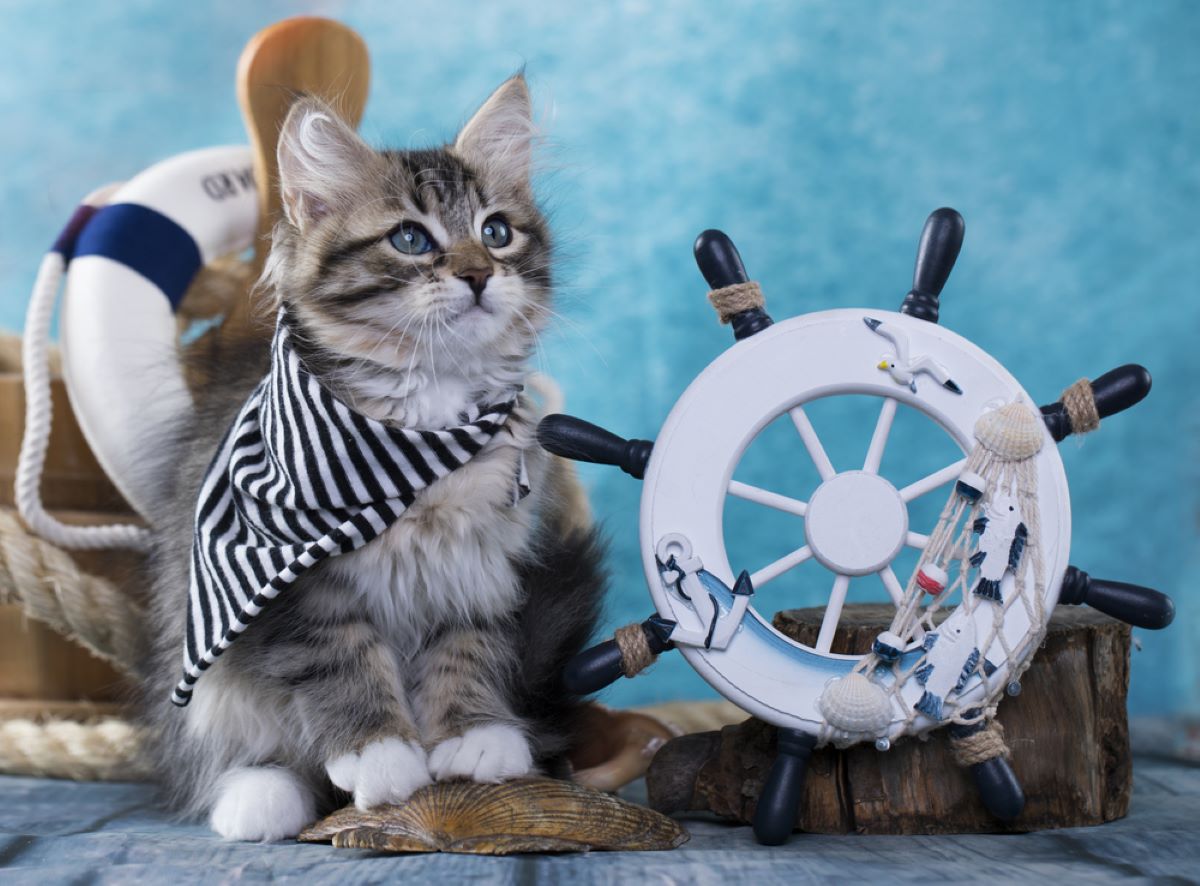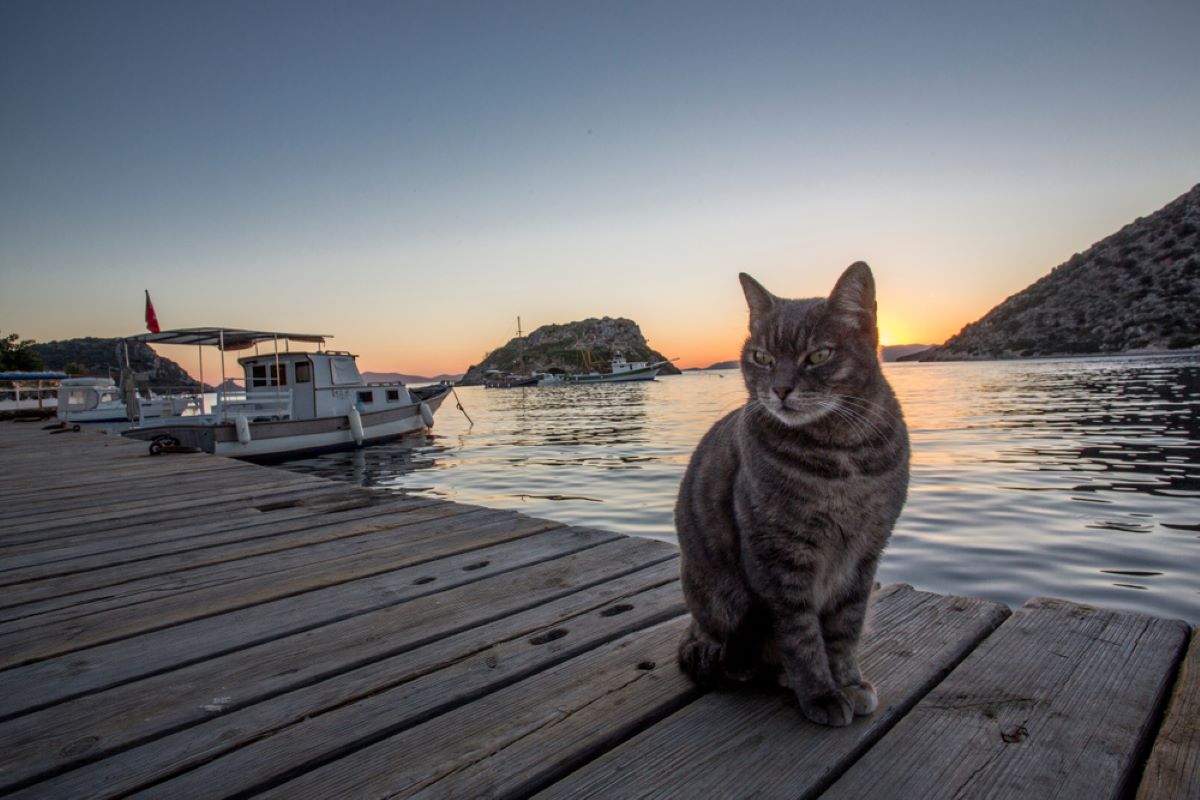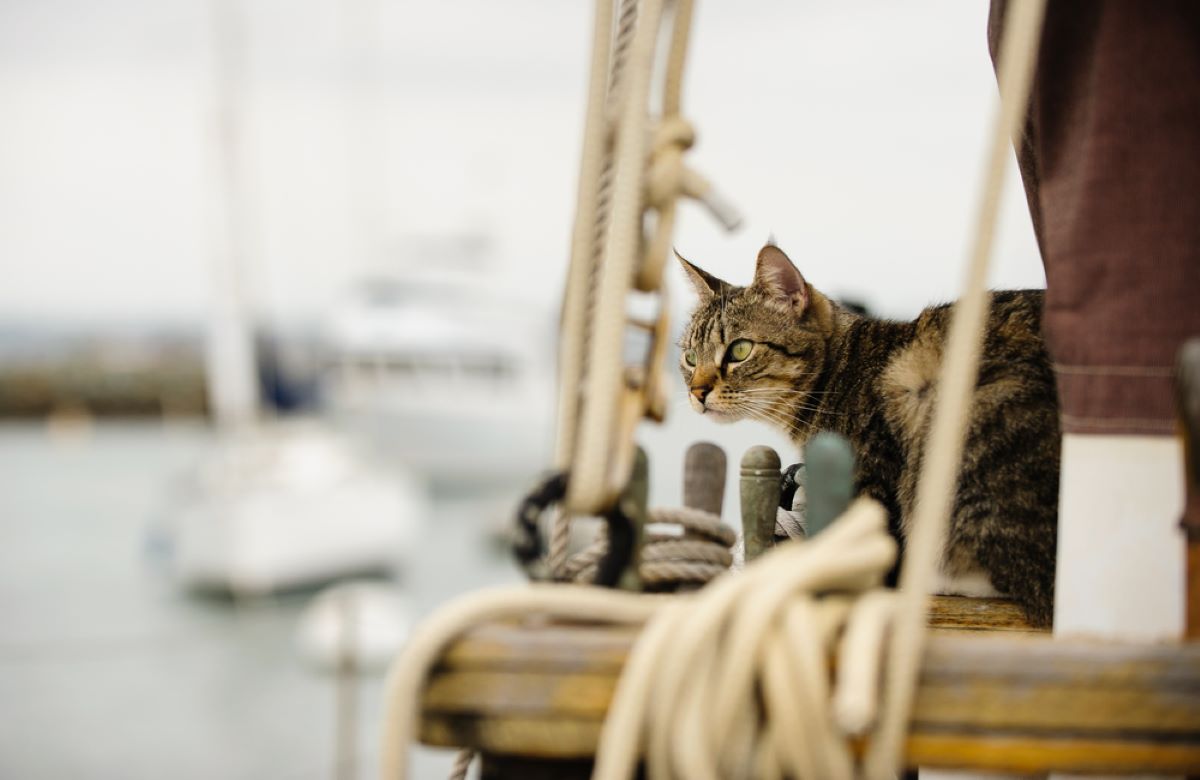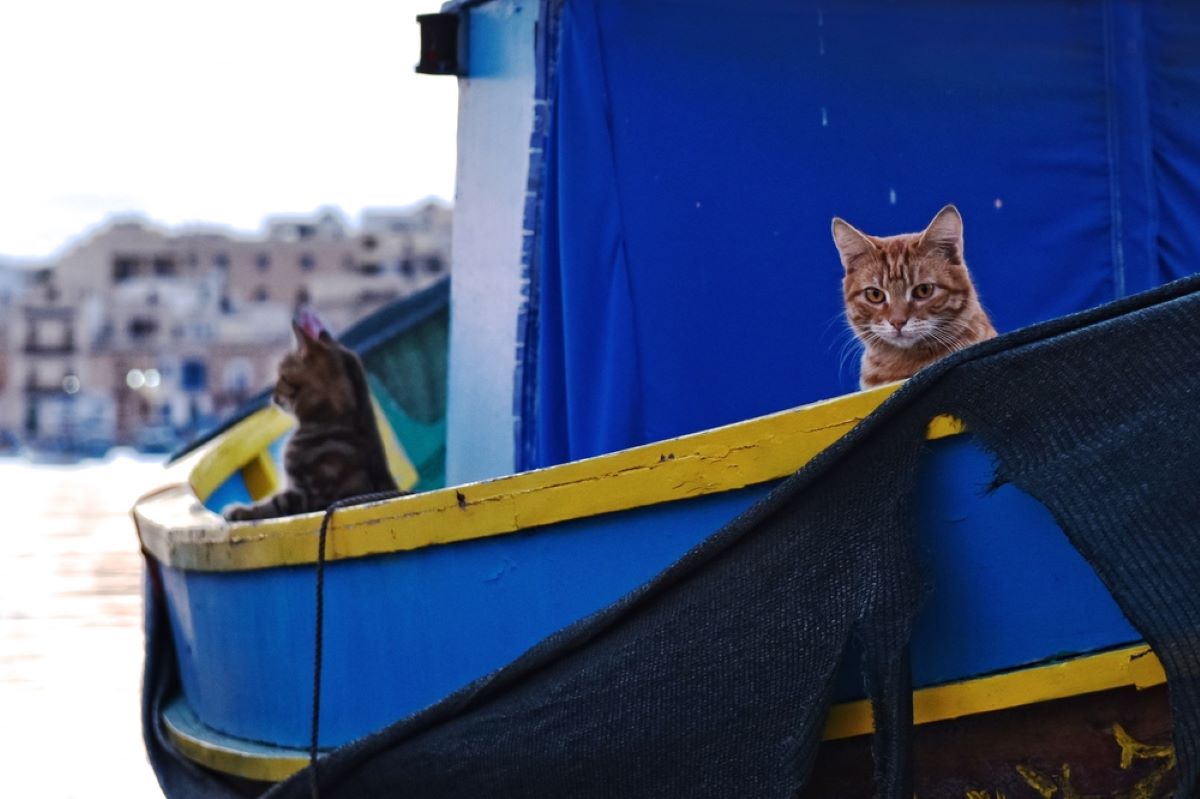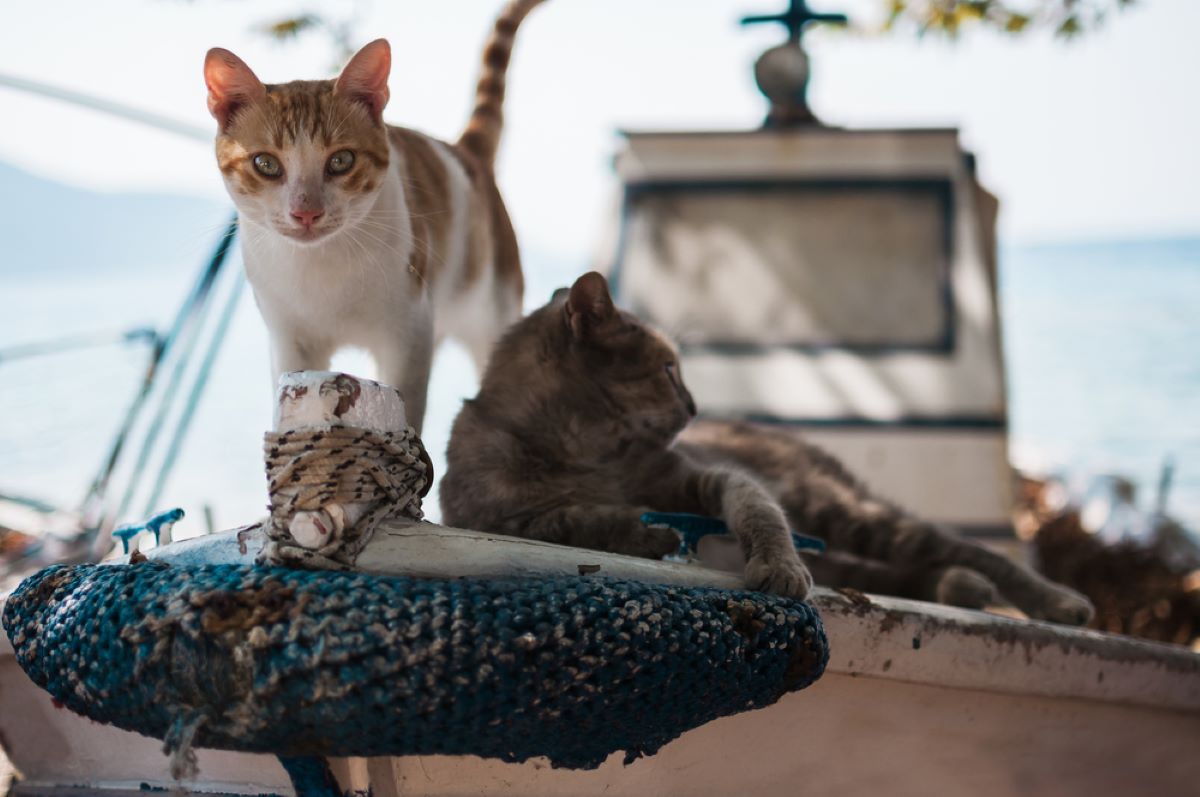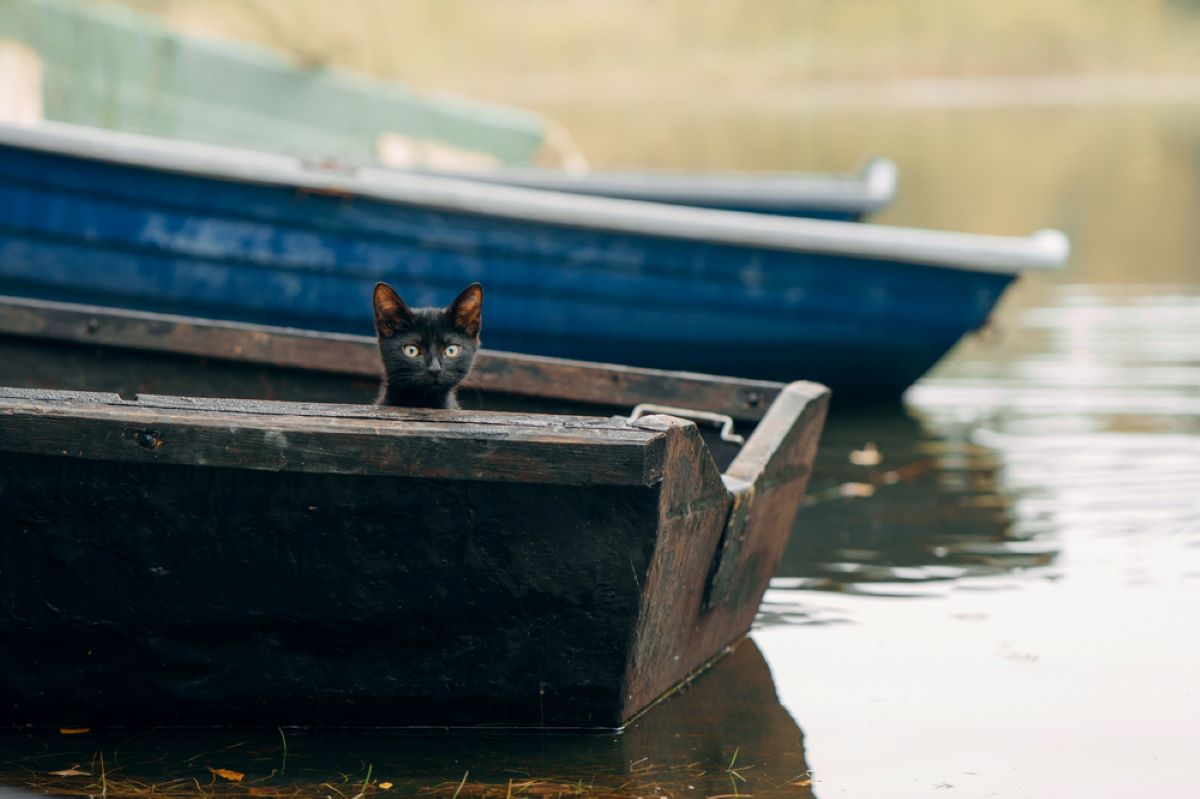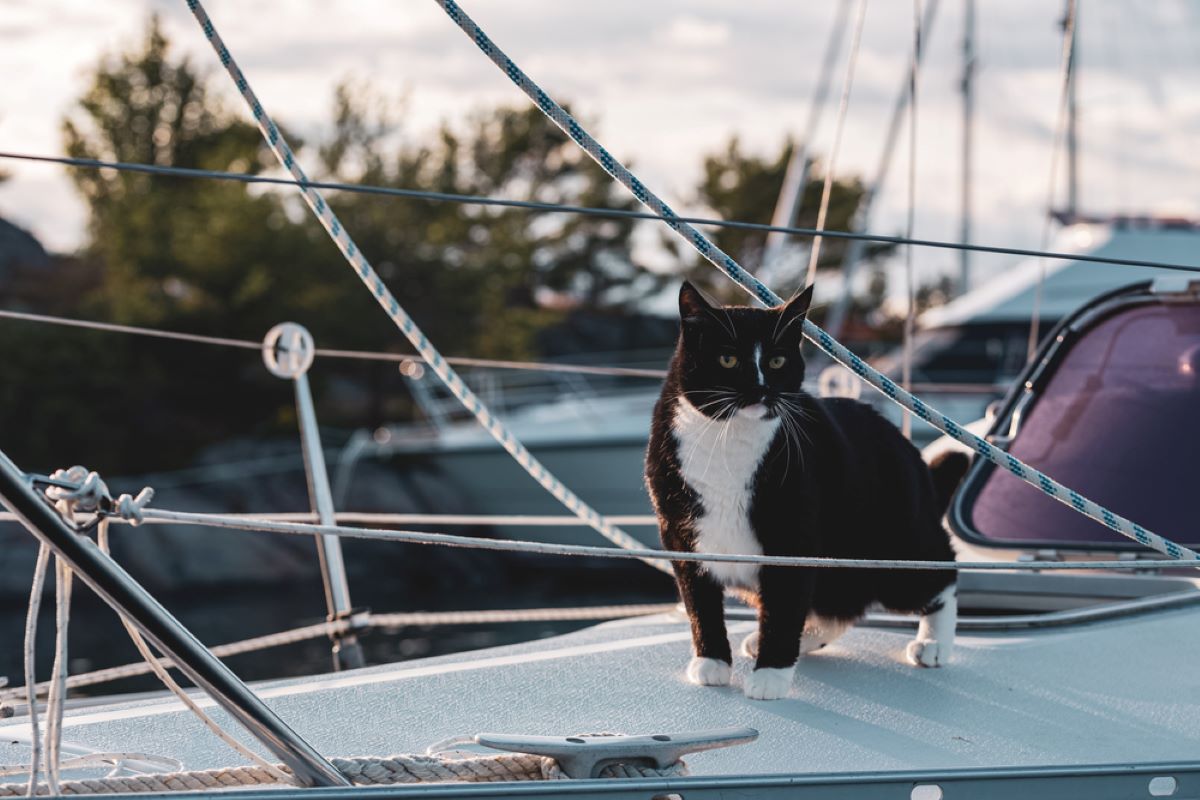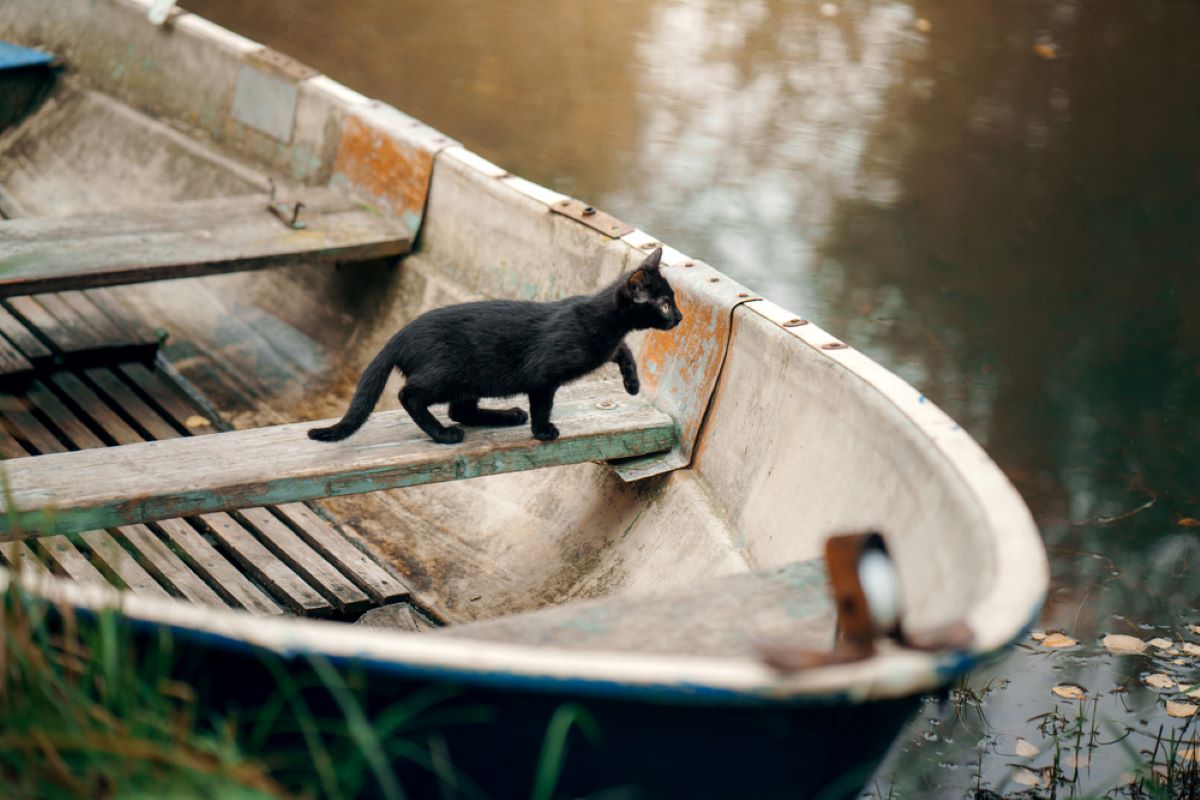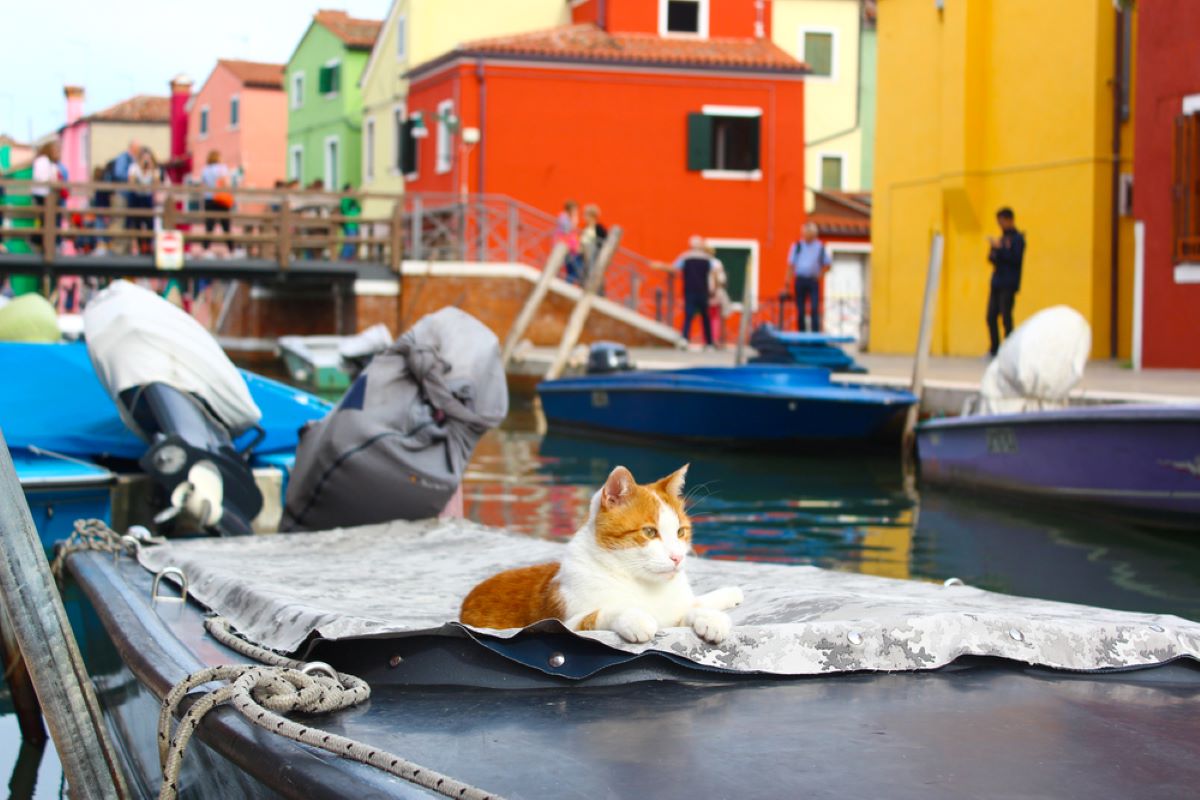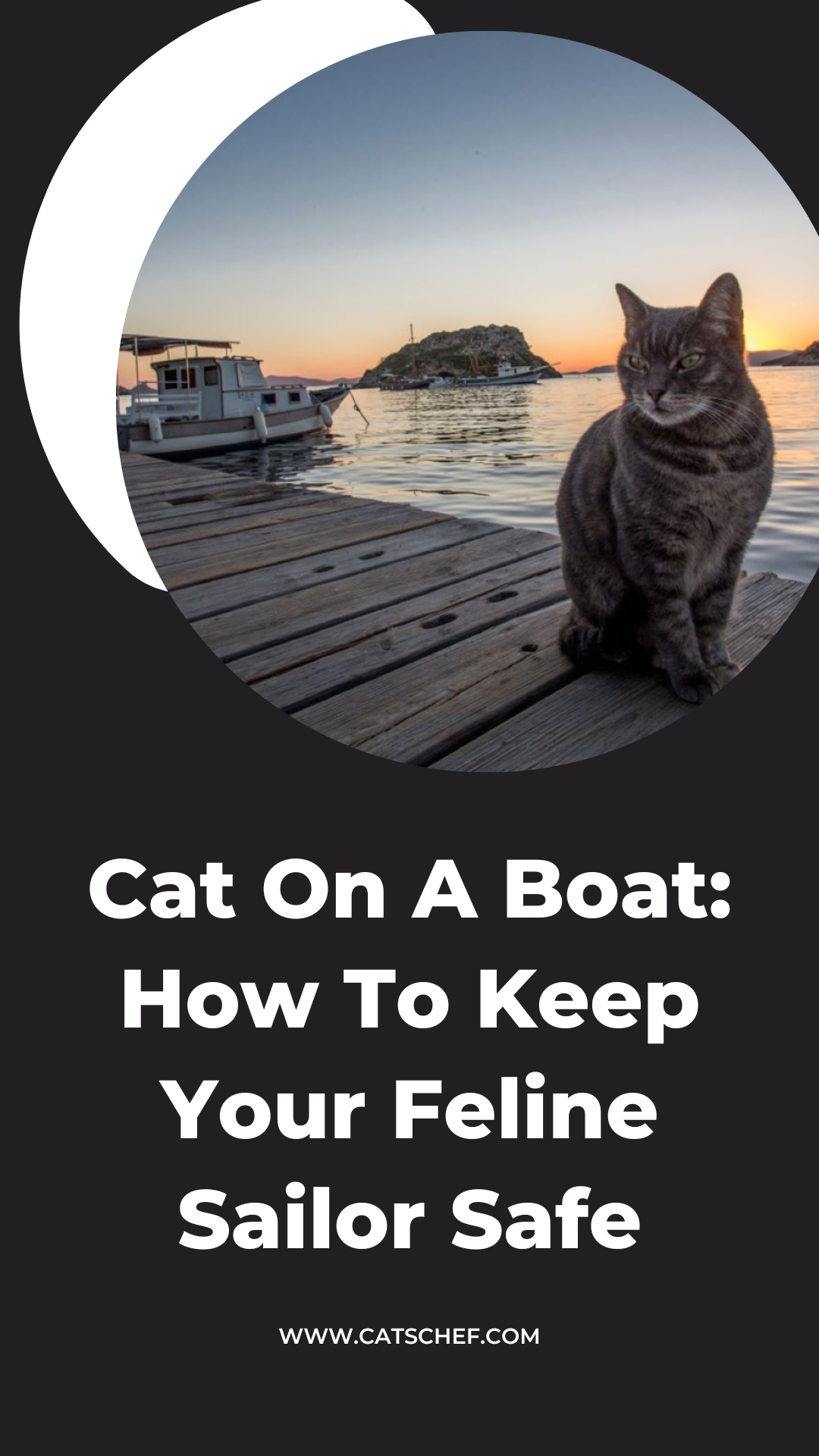📖 Table of Content:
Regardless of if you’re planning a one-day field trip or living on a boat, you probably want your pet beside you. It’s normal to see people bringing their pups along, but what about felines? Would it be okay to bring a cat on a boat? How would she adapt?
One of the first things that come to mind when we think of felines is their hatred of water. That might be why we haven’t seen them accompany sailors all that much. Or so we think. But, in actuality, cats used to be pretty popular among them. Most of all because they helped keep the boat clear of rats.
But how would our modern companions adapt to the rough conditions of the waters? Would they have no issues like their ancestors or is bringing a cat on a boat a bad idea? How would they react in the case of potential accidents?
Dogs tend to be pretty good swimmers, so they aren’t likely to drown. But would our gentle furballs have the same set of skills to survive? What are some other possible dangers if there are any? And are there any benefits of bringing your feline along? Let’s find out!
Is it safe to bring a cat on a boat?
Our primary concern when considering taking our feline along is if it’s safe for her. We need to take a look at all the possible dangers of a cat on a boat. As well as how to meet the requirements of safe sailing with a furball. Some of these include:
1. Swimming
Although most cats hate water, it’s extremely important for them to know how to swim. In case of an accident, it’s not guaranteed that you’ll be able to reach her quickly enough. So, she needs to be able to survive in the water long enough for you to be able to save her.
Luckily, testing if your feline can swim is pretty easy, and you can do it at home. Fill your bathtub up with water and gently lower your furball into it while staying close. She should have a natural instinct to stay afloat. But if she panics and starts kicking around, she might need more time to adjust.
You can also try this in a pool if you have access to one. Just make sure that you stay by her side the entire time to avoid any incidents. If she hates the water so much that she can’t even go near it, she’s not the right kitty for sailing.
2. Life vests
Life vests are crucial for all passengers and that includes cats. Finding one for your feline might be a bit difficult though. And that’s because there aren’t any specifically designed for cats. Luckily though, you can use those made for dogs if you find the right size.
3. Sunscreen
No, your kitty won’t be working on her tan with you. However, she’ll still need that sunscreen. Especially if you’re not planning to keep her below deck. Too much sun can be harmful to cats just as it is to humans, especially if you have a hairless feline.
4. Safety net
If your cat has access to the deck, there’s always a possibility of her falling into the water. If that happens, your best option for taking her out is a safety net. That way you can just scoop her out without causing too much stress.
Getting your cat used to the boat
Before you can sail off with your feline, you need to make sure she feels comfortable on the boat. She’ll be spending a lot of time on board, so she needs to get used to it. This is a process that takes some time, so you’ll need to be patient and understanding.
The first step you can take is to get some stuff from the boat and bring it to your cat. This should ideally be a blanket or a pillow or anything she can sniff. Getting to know the scent of the boat will make it much less stressful for her to adapt to being on it.
Next, you can try to let her spend some time on the boat while it’s still in the dock. This will help her get used to some gentle waves and movement. It can also give her the opportunity to explore the vessel and get used to all of its parts.
Making it comfortable
Once your cat gets used to spending time on the boat, you can start bringing her stuff. These things will help her feel more at home. It will also make it easier for you to keep your vessel clean and tidy. So, what are some essentials when bringing a cat on a boat?
1. Litter box
A litter box is a definite must-have on a boat. Your feline needs to pee and poo somewhere and I don’t think you’d want her doing her business just anywhere. We usually recommend an open litter box, but in this case, you might want to have one with a lid.
Although open litter boxes are usually better for cats in every sense, a closed one is safer on a boat. If your vessel gets caught up in larger waves, things will probably start flying around. That’s why a tightly shut litter box makes the least mess.
The type of litter you use is also very important. Scented litters tend to produce an extremely foul smell when mixed with feces. And that’s the last thing you’d want in a small space like a boat. So, make sure you get high-quality, unscented litter.
2. Plenty of toys
This goes for all felines, but especially those that are highly active. If your cat has nothing to keep her busy and entertained, she’ll start making trouble. And on a thing as sensitive as a boat, this can become very problematic.
Bringing enough toys should be of great help. Especially if you have interactive toys. Your kitty will have a good time and have fun by herself. And you won’t have to worry about her causing problems. Still, if you can manage to keep her engaged with your activities too, she’ll behave even better.
3. Food
If you’re planning to stay for an extended period, you’ll definitely need food. You might wonder if you can give your cat some fish while on the waters. Sadly, the answer is a definite no. Especially if you were planning to give her raw fish.
Raw fish contains parasites that can harm your feline’s health. And even when the fish is cooked, your cat shouldn’t eat much of it. Fish isn’t part of her regular diet, so basing her meals on it for a day or more isn’t advised. She can have a piece or two, but you shouldn’t try to substitute her entire diet with it.
So, be sure to bring plenty of cat food. You’ll need to pack it securely and tightly, so it doesn’t go flying around when the waves come. No one wants to clean cat food off of the walls or to get hit in the head by a can.
4. Leash
If you want your cat to spend time with you on the deck, you should get a leash. Although cats hate water and your furball probably doesn’t want to jump in, she might still fall in. So, to make sure she stays safe, a leash is the best option. She’ll be able to explore around without you worrying.
5. You!
Most of all, your cat needs you. Boat trips and changing the environment, in general, can be very stressful for felines. And the thing that can soothe her the best is you. While you’re on the vessel, make sure your furball doesn’t feel left out.
Spend a lot of time with her and make sure you get her engaged in whatever you’re doing. The best way to do so is to let her sniff things. It helps her feel included and it prevents her from feeling lonely and anxious.
Can a cat on a boat get motion sickness?
Just like people, cats can get motion sickness. And just like people who get sick avoid boat trips, your furball should, too. One way to see if she has this condition is to take her on short trips. Monitor her behavior and be out on the lookout for symptoms.
These can include vomiting, diarrhea, drooling, anxiety, restlessness, or any sort of visible discomfort. You should consult a veterinarian about these issues. He can recommend some medicine against motion sickness, as well as give you advice on how to ease it.
How to know if your cat isn’t ready for a ride
There are some general indicators that show that a feline might not be the right cat for sailing. If you’re having doubts about her, try to keep an eye out for these signs. They make it very clear that your furball would be too uncomfortable to endure being aboard.
1. Overly timid
If you own a scaredy cat, chances are she’ll most likely hate the ride. Overly timid felines have a hard time adjusting to any changes. They can become stressed when you change the furniture or have guests over. So, you can imagine how hard a boat ride would be for them.
2. A senior feline
Cats that have entered their later years are probably not best suited for any kind of traveling. They tend to get tired much faster than other felines and they generally don’t respond well to changes. Some also have health issues that make boat trips even harder to accomplish.
3. A cat that hates traveling
Does your cat get restless or hissy during car rides? If she does, she most likely won’t enjoy being on a boat either. Felines that hate one form of transport tend to hate any kind of traveling. And a boat ride is usually a lot bumpier than a simple car ride.
4. They hate water
It might not seem like a big deal if your cat hates water. After all, they’ll be on the boat and not swimming, right? Well, we can’t afford to think that way for two reasons. One is the very real possibility of accidents happening.
If your feline falls into water, she needs to be able to put up with it enough to swim. If she panics too much out of fear, she might drown. And the other reason is stress. You don’t want the ride to be uncomfortable for your cat. If she’s terrified of water, she won’t be able to relax when surrounded by it.
Are there breeds better suited for boat rides?
We’ve talked about all the problems that your feline might face while on a boat. And some of the most prevalent ones are the fear of water, motion sickness, and anxiety caused by the change of environment. So, are there breeds that adapt better to these conditions than others?
And the answer is an absolute yes! There are cat breeds that completely adore water, so the fear of being surrounded by it won’t be a problem. And some of these breeds also have a very adventurous spirit, so they aren’t as likely to get anxious.
1. Bengal cat
Bengal cats are one of the biggest troublemakers. This is due to their high levels of energy and curious personality. So, they’re almost sure to love boats! What would be stressful to most other felines would just be a very fun adventure to them.
And the best part? They tend to adore water! They’ll be exploring the vessel, admiring the waves, and simply having fun with you. Just be careful not to let them become bored. If you don’t entertain Bengals, they’ll entertain themselves by causing problems.
2. Norwegian Forest cat
What better cat to bring along than a breed that was originally kept on Viking ships? These furballs were kept on boats because of their amazing skill at hunting mice and rats. They’re genetically used to the conditions present at sea.
They’re less likely to have motion sickness and they don’t fear water. They’re the ideal cats to have by your side on a boat thanks to their calmness. The adapting will take much less time and you’ll have a furry Viking on board!
3. Maine Coon
Maine Coons are very similar to Norwegian Forest cats. But, they do have one more great attribute. And that’s the fact that they’re absolutely fascinated by water. They’re known for playing with taps or any water source available.
So, you can bet that they’ll adore sitting next to you and watching the waves. They’re highly intelligent and love human company. They’re a great choice if you want a peaceful boat ride without any major problems.
4. Turkish Van
Want to bring a cat on a boat? Why not bring the feline that was aboard Noah’s Ark? According to Turkish folklore, the Turkish Van was one of the many animals that were part of Noah’s Ark’s passengers, and God blessed it with a ruddy patch of fur on its head.
So, the feline definitely has experience with boats. And they’re also pretty great swimmers. They have everything it takes to be a part of your little crew. They love the water, so the trip will be an amazing experience for them.
5. Egyptian Mau
The Egyptian Mau is another historical breed. There are depictions of them dating back to the ancient Egyptians. They were used for duck hunting, so you can bet that a little water doesn’t bother them. They might not adore it like some other breeds, but they definitely have no problem with it.
The Egyptian Mau is a very confident breed that is very unlikely to get shaken up by a boat ride. They still need time to adapt just like all other cats. But they probably won’t freak out or become overly anxious. So, they make for a very good companion for boat rides.
6. American Bobtail
These unique cats got their name after their adorable short tails. They’re very lively and adventurous, so they would love to participate in a boat ride. They are also very adaptable, so the ride shouldn’t be stressful for them.
Another plus is that they love playing with water. They’ll actively seek it out. So, it’s highly unlikely for them to display any sort of fear or stress around it while on the boat. With the proper training, they’re certain to be great company.
7. British Shorthair
The British Shorthair might be one of the best choices out there. They’re very calm and collected by nature, so they shouldn’t have a hard time adjusting. And since they love being close to their owner, they’re unlikely to cause trouble out of boredom.
They also have a very unique relationship with water. Unlike most other breeds, the British Shorthair looks at water with curiosity and not fear. They’re known to come rushing to their humans when they’re having a shower. They also love playing with tap water.
8. Abyssinian cat
Another great option if you’re hoping to bring a cat on a boat is the Abyssinian. They’re a very curious and playful breed that rarely fears anything. They’ll love exploring around the boat and spending time with you watching the tides and waves.
The Abyssinians are very good swimmers, too. That’s because Japanese sailors used to keep them as mousers and good luck charms. (So, you should have good luck while sailing, too!) They’re definitely one of the best felines you could choose to bring along on your boat.
9. Savannah cat
These little leopards can make for amazing sailing companions. They’re fearless and adventurous and they absolutely adore exploring new areas. The Savannah would adapt to staying on a boat much faster than most other breeds.
Just be careful so they don’t jump into the water! These cats love splashing around and causing a mess. They definitely won’t be afraid, but make sure they don’t get overly excited. Always keep them on a leash when they’re on the deck and never take your eyes off of them.
10. Sphynx cat
These felines were basically forced to put up with water until they eventually got used to it. Their hairless body makes it obligatory for them to have baths to keep their skin healthy. If you want a cat that isn’t afraid of water but isn’t too keen on jumping in either – consider the Sphynx!
They also love exploring without being overly energetic. They’ll feel comfortable enough to walk around the vessel. But they’ll also enjoy just curling up next to you and enjoying the fresh breeze and sound of waves. Just make sure to train them beforehand.
So, are you ready to bring a cat on a boat?
As you could tell, the decision to bring a cat sailing all depends on the breed and the individual feline’s personality. Some cats love experiencing new things, and some would just rather relax at home. The important thing is to not push your cat out of her comfort zone.
Doing what’s best for your furball should always be your top priority. If a boat trip would cause her stress and anxiety, then taking her along just isn’t worth it. She would have a horrible time and you wouldn’t be able to enjoy yourself either.
However, if your cat does seem like she could use an adventure, by all means, go for it! It could prove to be an incredible bonding experience for the two of you. It could also make her happier to change the scenery every once in a while.
So, if you do decide to bring her along, just make sure you take care of all her needs first. These include making sure that she’s safe and that you have everything necessary to help her in case of an accident. As well as supplying the boat with all the things she needs for comfortable sailing.
